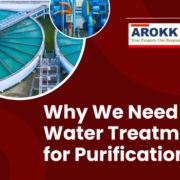Why We Need Water Treatment for Purification
/0 Comments/in Facility Management/by Arokk Integreted Management Services Pvt. Ltd.Water treatment not only ensures that our drinking water is free from harmful contaminants but also plays an important role in maintaining our daily hygiene and overall public health.
It supports agricultural and industrial activities, which rely heavily on clean water. Understanding and supporting water treatment processes is essential for preserving this vital resource for ourselves and future generations.
Effective water treatment processes, including sewage wastewater treatment, reduce the burden on our environment by minimising the release of pollutants into natural water bodies. This protection is vital for aquatic life and helps maintain the natural balance of ecosystems.
By investing in and enhancing water treatment infrastructure, such as sewage wastewater treatment facilities, communities can ensure a continuous supply of clean and safe water, fostering better health and a more sustainable future.
What is Water Treatment?
Water treatment involves several processes aimed at removing contaminants from water to make it safe for drinking, cooking, and other daily uses.
The goal is to eliminate harmful substances that can cause sickness, and long-term health issues, or impact the environment negatively.
Water treatment plants use a combination of physical, chemical, and biological processes to purify water and ensure it meets safety standards.
Here are the few water treatment processes
- Physical Processes: These include filtration and sedimentation that remove large particles and sediment from water, clarifying it before chemical treatment.
- Chemical Processes: Chemicals like chlorine are added to disinfect the water, eliminating pathogens that cause diseases and adjusting the water’s pH to safe levels.
- Biological Processes: Biological treatments involve using microorganisms to degrade organic matter in the water, which is especially useful in treating wastewater before it is released back into the environment.
Why is Water Treatment Necessary?
Water treatment also mitigates the effects of pollution by filtering out heavy metals, pesticides, and other hazardous chemicals that can seep into water sources from agricultural and industrial activities.
By removing these contaminants, water treatment processes prevent potential health risks such as cancer, reproductive issues, and developmental problems.
Furthermore, treating water enhances its quality for recreational purposes, ensuring safe swimming, fishing, and boating activities.
This comprehensive approach not only safeguards human health but also helps sustain wildlife and promotes tourism by maintaining pristine natural environments.
Health Protection
Untreated water can carry diseases such as cholera, dysentery, and typhoid, which are primarily spread through contaminated water. Water treatment removes these pathogens and harmful bacteria, ensuring the water we drink does not harm our health.
Environmental Sustainability
Treating wastewater before releasing it back into the environment prevents pollutants from harming aquatic life and ecosystems. Effective water treatment reduces pollution, protects biodiversity, and helps maintain the ecological balance.
Economic Benefits
Investing in water treatment technology and infrastructure boosts economic development by safeguarding public health and reducing healthcare costs associated with waterborne diseases. Additionally, it supports industries that depend on clean water for their operations, thereby sustaining jobs and contributing to the economy.
How Does Water Treatment Work?
Screening and Pre-treatment
The first step in water treatment involves removing large debris, such as sticks and trash, from the water. This is typically done through a screening process.
Coagulation and Flocculation
Chemicals with a positive charge are added to the water. These chemicals neutralize the negative charge of dirt and other dissolved particles in the water. Once neutralised, the particles bind with the chemicals and form larger particles, known as floc.
Sedimentation
The floc settles to the bottom of the water supply, due to its weight. This settling process is called sedimentation.
Filtration
The clear water on top will pass through filters of varying compositions (sand, gravel, and charcoal) and pore sizes, to remove dissolved particles, such as dust, parasites, bacteria, viruses, and chemicals.
Disinfection
After the water has been filtered, a disinfectant (like chlorine or chloramine) might be added. This step kills any remaining parasites, bacteria, viruses, and germs. The water is now safe to drink.
pH Adjustment and Fluoridation
The final step involves adjusting the pH of the water and adding fluoride, which helps to protect teeth.
Challenges in Water Treatment
Water treatment faces several challenges, including aging infrastructure that can lead to inefficiencies and water losses through leaks and breaks. Emerging contaminants like pharmaceuticals and microplastics present new hurdles as they are not always effectively removed by conventional treatment processes.
Financial constraints also hinder the upgrade and expansion of water treatment facilities, especially in developing regions.
Climate change impacts water availability and quality, increasing the complexity of water treatment. Addressing these challenges requires continuous innovation and investment in water treatment technologies and infrastructure.
Infrastructure Issues
Ageing infrastructure can lead to inefficiencies in water treatment processes and water leaks, resulting in significant water loss.
Chemical Contaminants
Emerging chemical contaminants pose new challenges for water treatment plants. These include pharmaceuticals, personal care products, and endocrine-disrupting chemicals that standard treatment processes may not currently address.
Resource Limitations
In many parts of the world, there is a lack of financial resources to invest in advanced water treatment facilities, which limits access to clean water.
How Facility Management Contributes to Effective Water Management and Conservation?
Facility management company plays a crucial role in optimising water treatment at the domestic level. By implementing efficient systems such as point-of-use filters, reverse osmosis units, and water softeners, homeowners can enhance the quality of their drinking water.
Facility managers can introduce rainwater harvesting systems to supplement household water usage, which reduces dependence on municipal systems and alleviates strain on public water sources. Regular maintenance of plumbing systems also prevents potential contaminants from entering the home’s water supply, ensuring the water remains safe for all household uses, thus supporting overall health and sustainability.
Conclusion
As our planet faces increasing water quality challenges, the role of water treatment becomes ever more critical. By ensuring clean water through effective treatment processes, we support not only human health but also environmental sustainability and economic stability.
The ongoing advancements in water treatment technology are promising, leading us towards a clearer future where clean water is accessible to all. This essential resource management ensures our well-being and the health of future generations, paving the way for a thriving, sustainable world.

